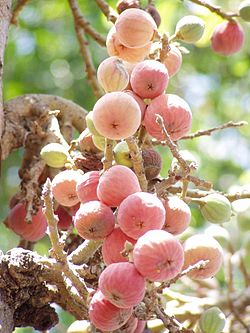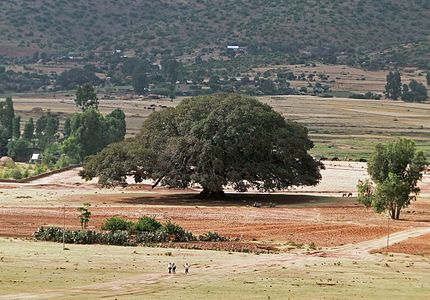Ficus sycomorus
Species of fig From Wikipedia, the free encyclopedia
Ficus sycomorus, called the sycamore fig or the fig-mulberry (because the leaves resemble those of the mulberry), sycamore, or sycomore, is a fig species that has been cultivated since ancient times.[2]
| Ficus sycomorus | |
|---|---|
 | |
| Leaves and syconia of Ficus sycomorus | |
| Scientific classification | |
| Kingdom: | Plantae |
| Clade: | Tracheophytes |
| Clade: | Angiosperms |
| Clade: | Eudicots |
| Clade: | Rosids |
| Order: | Rosales |
| Family: | Moraceae |
| Genus: | Ficus |
| Subgenus: | F. subg. Sycomorus |
| Species: | F. sycomorus |
| Binomial name | |
| Ficus sycomorus | |
 | |
Etymology and naming
The specific name came into English in the 14th century as sicamour, derived from Old French sagremore, sicamor. This in turn derives from Latin sycomorus, from Ancient Greek σῡκόμορος (sykómoros) 'fig-mulberry'. The Greek name may be from the Greek tree-names sykón 'fig' and moron 'mulberry', or it may derive from the Hebrew name for the mulberry, shiqmah.[3]
The name sycamore spelled with an A, has also been used for unrelated trees: the great maple, Acer pseudoplatanus, or plane trees, Platanus. The spelling "sycomore", with an O rather than an A as the second vowel is, if used, specific to Ficus sycomorus.[4][5]
Distribution
Ficus sycomorus is native to Africa south of the Sahel and north of the Tropic of Capricorn, excluding the central-west rainforest areas. It grows naturally in Lebanon; in the southern Arabian Peninsula; in Cyprus; in very localised areas in Madagascar; and in Israel, Palestine and Egypt. In its native habitat, the tree is usually found in rich soils along rivers and in mixed woodlands.[citation needed]
Description
Ficus sycomorus grows to 20 m tall and has a considerable spread, with a dense round crown of spreading branches. The leaves are heart-shaped with a round apex, 14 cm long by 10 cm wide, and arranged spirally around the twig. They are dark green above and lighter with prominent yellow veins below, and both surfaces are rough to the touch. The petiole is 0.5–3 cm long and pubescent. The fruit is a large edible fig, 2–3 cm in diameter, ripening from buff-green to yellow or red. They are borne in thick clusters on long branchlets or the leaf axil. Flowering and fruiting occurs year-round, peaking from July to December. The bark is green-yellow to orange and exfoliates in papery strips to reveal the yellow inner bark. Like all other figs, it contains a latex.
The fruit is produced year round, starting in April or a bit later depending on variety, and continuing into winter. It is sometimes separated into five successive "crops".[6]
Cultivation
Summarize
Perspective
Two major varieties are known in Egypt. Roumi (also called Falaki or Turki), which has more horizontally spread branches, stouter shoots and petioles, more densely spaced leaves that are wider than they are long, and larger, flatter, broad pink fruits; and Kelabi (also called Arabi or Beledi), which has more vertical branches, is more slender, has smaller leaves and has smaller yellowish pear shaped fruits.[6]
In modern history, many Egyptians would once a year (on the day of a particular saint) make a ring of bruises and cuts around the base of their sycamore trees.[why?][6]
According to botanists Daniel Zohary and Maria Hopf, cultivation of this species was "almost exclusively" by the ancient Egyptians.[2] Remains of F. sycomorus begin to appear in predynastic times and occur in quantity from the start of the third millennium BC. It was the ancient Egyptian tree of life.[7] Zohary and Hopf note that "the fruit and the timber, and sometimes even the twigs, are richly represented in the tombs of the Egyptian Early, Middle and Late Kingdoms."[2] In numerous cases the parched fruiting bodies, known as sycons, "bear characteristic gashing marks indicating that this art, which induces ripening, was practised in Egypt in ancient times."[2]
Although this species of fig requires the presence of the symbiotic wasp Ceratosolen arabicus to reproduce sexually, and this insect is extinct in Egypt, Zohay and Hopf have no doubt that Egypt was "the principal area of sycamore fig development."[2] Some of the caskets of mummies in Egypt are made from the wood of this tree. In tropical areas where the wasp is common, complex mini-ecosystems involving the wasp, nematodes,[8][9] other parasitic wasps, and various larger predators revolve around the life cycle of the fig. The trees' random production of fruit in such environments assures its constant attendance by the insects and animals which form this ecosystem.
Sycamores were often planted around artificial pools in ancient Egyptian gardens.[10]
The sycamore tree was brought to Israel by Philistines during the Iron Age, along with opium poppy and cumin.[11][12] These sycamore trees used to be numerous in western Beirut, lending their name to the neighborhood of Gemmayzeh ((الْجُمَّيْزَة al-Ǧummayzah), "sycamore fig").[13] However, the trees have largely disappeared from this area.[14]
Gardens
In the Near East F. sycomorus is an orchard and ornamental tree of great importance and extensive use. It has wide-spreading branches and affords shade.
In religion
Summarize
Perspective
Judaism and Christianity

In the Hebrew Bible, the sycomore is mentioned seven times (Biblical Hebrew: שִׁקְמָה, romanized: shiqmā; Strong's number 8256) and once in the New Testament (Koinē Greek: συκομoραία, romanized: sykomoraia or συκομορέα sykomorea;[15] Strong's number 4809). It was a popular and valuable fruit tree in Jericho and Canaan.[16]
In El Matareya, there is a sycamore known as the Tree of the Virgin, which serves as a pilgrimage site. It is not the same tree; instead, when the previous tree that stands in this spot dies, a new one is planted from cuttings of the old tree.[17] It is said that the Holy Family took refuge in this tree.[18] The Coptic pope Theophilus also recounted that Joseph had a walking stick, which an infant Jesus broke. When Joseph buried the pieces of the stick, a sycamore grew forth and provided shelter.[19]
Other religions
In Ancient Egypt, the sycamore was associated with the goddesses Hathor, Isis, and Nut. In the case of the latter, prayers exist referring to the "sycamore of Nut", and asking for water and breath. These goddesses were sometimes depicted as trees, sometimes standing in front of them with vessels of water, or sometimes as a tree with human body parts, such as an arm or breast. It was the most significant depicted life giving tree in ancient Egypt.[20] Sycamores are referenced in ancient Egyptian love poetry as a meeting place for lovers.[20][10] There are references to twin sycamores of turquoise in funerary contexts which Ra comes forth from, indicating they likely face east,[20] or are located on the eastern horizon.[10]
In modern Egyptian folklore, the sycamore retains an association with mysticism and magic. In the story "It Serves Me Right!", it is used to represent the Tree of Lifespans. The fruit from this tree dries up at the end of a life, but is fresh when one still has more life to live. Therefore, the inhabitants of a land found at the bottom of a well in the story only eat the dry, bad sycamore fruits and leave the good ones alone.[21]
In Kikuyu religion, the sycomore is a sacred tree. All sacrifices to Ngai (or Murungu), the supreme creator, were performed under the tree. Whenever the mugumo tree fell, it symbolised a bad omen and rituals had to be performed by elders in the society. Some of those ceremonies carried out under the Mugumo tree are still observed.[22][23]
Gallery
- Leaves
- Trunk with unripe fruit
- Fruit
- In Ethiopia
See also
References
External links
Wikiwand - on
Seamless Wikipedia browsing. On steroids.





